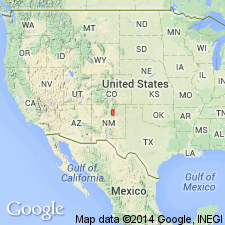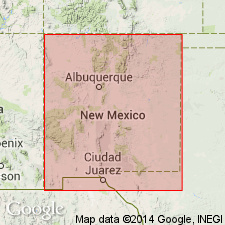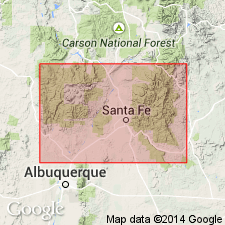
- Usage in publication:
-
- Manuelitas member*
- Modifications:
-
- Named
- Dominant lithology:
-
- Conglomerate
- Limestone
- Sandstone
- Siltstone
- Shale
- Chert
- AAPG geologic province:
-
- Many basins
Summary:
Named as middle of 3 members of Tererro formation (all new). Type section measured on hill north of Manuelitas Creek (for which probably named) 500 ft north of Co Rd where exposed at west end of gap 1.6 mi east of Lower Rociada, San Miguel Co, where Manuelitas Creek flows eastward from Rociada Valley into a narrow canyon. Composed of a complex sequence of limestone-pebble-and-cobble conglomerate, calcarenite (mainly calcite sand), sandy and silty limestone, siltstone, marly shale, and crystalline limestone. The crystalline limestones weather gray and have an earthy appearance; the clastic rocks tend to weather buff or light yellowish gray. Limestones in lower part are siliceous and contain brown-weathering chert; upper part, particularly coarse calcarenite, characterized by light-gray or pink oolitic chert, a distinguishing feature of member. Unconformably overlies Macho member; unconformably underlies Cowles member. Intramember unconformities common; beds of Manuelitas were involved in collapse into large sinkholes of Macho and underlying Espiritu Santo formation (new) during deposition of Manuelitas. Present throughout most of Sangre de Cristos (except along western margin, where rocks have been cut out or concealed by overthrust rocks of Precambrian age) in Taos, Mora, San Miguel, and Santa Fe Cos, NM, in San Luis, Las Vegas-Raton, Palo Duro, and Estancia basins. Lower-bed fossils indicate Early Mississippian age. Sections.
Source: GNU records (USGS DDS-6; Denver GNULEX).

- Usage in publication:
-
- Manuelitas Member
- Modifications:
-
- Age modified
- AAPG geologic province:
-
- Estancia basin
- San Luis basin
- Palo Duro basin
- Las Vegas-Raton basin
Summary:
Age of Tererro Formation and its (ascending) Macho, Manuelitas, and Cowles Members modified. Age of Manuelitas Member of Tererro given by Baltz and Read (1960) as Early Mississippian, based on faunule found in Manuelitas Member; in this report, species of ENDOTHYRA have been collected from all three members of Tererro, studied by Zimmerman of Sun Oil Co. Research Laboratory, and found to be definitely Meramecian age. Since none of the fossils (primarily brachiopods) listed by Baltz and Read (1960) were identified with certainty and were poorly preserved as well, the well-preserved endothyrid faunas of this report are believed to provide a more reliable indication of probable age. The entire Tererro Formation is therefore best considered to be of Meramecian (Late Mississippian) age, as previously proposed by Armstrong (1958), who studied endothyrid faunas from various Mississippian localities in northern NM. Tererro present throughout most of Sangre de Cristo Mountains (except along western margin, where rocks have been cut out or concealed by overthrust rocks of Precambrian age) in Taos, Mora, San Miguel, and Santa Fe Cos, NM, in San Luis, Las Vegas-Raton, Palo Duro, and Estancia basins. Present in Rincon, Santa Fe, Taos, and western part of Truchas Ranges. Geologic map, measured sections.
Source: GNU records (USGS DDS-6; Denver GNULEX).

- Usage in publication:
-
- Manuelitas Member*
- Modifications:
-
- Age modified
- Biostratigraphic dating
- Revised
- AAPG geologic province:
-
- Palo Duro basin
- Las Vegas-Raton basin
- San Juan basin
Summary:
Lower contact of Manuelitas Member of Tererro Formation (revised, age modified) of Arroyo Penasco Group (raised in rank to group in this report) revised--now underlain in places by newly named Turquillo Member of Tererro. Age modified; age was given by Johnson (1972) in Geologic Atlas of the Rocky Mountain Region [figs. 1, 2, 4-6] as Osagean (Early Mississippian), but in this report age of Manuelitas is given as Meramecian (Late Mississippian) based on foraminifers, which clearly indicate a St. Louis [Limestone]--or Visean (Meramecian)--age. Is only member of Tererro present in western part of report area--San Pedro Mountain, Nacimiento and Jemez Mountains (Rio Arriba and Sandoval Cos, San Juan basin, NM), where it unconformably overlies Espiritu Santo Formation of Arroyo Penasco and unconformably underlies Log Springs Formation. Present in sections measured in eastern part of report area--at Mora Gap (Mora Co, Las Vegas-Raton basin); Coco City (Sangre de Cristo Mountains, Mora Co, Las Vegas-Raton basin); Jack's Creek (Sangre de Cristo Mountains, San Miguel Co, Palo Duro basin); and Tererro (San Miguel Co, Palo Duro basin)--where it unconformably underlies Cowles Member of Tererro, and overlies Turquillo Member or Macho Member, also of Tererro, where Turquillo is absent. [May be present in other places as well--areal limits not clearly stated.] Correlation chart, measured sections, discussion of depositional cycles, good lithologic description.
Source: GNU records (USGS DDS-6; Denver GNULEX).
For more information, please contact Nancy Stamm, Geologic Names Committee Secretary.
Asterisk (*) indicates published by U.S. Geological Survey authors.
"No current usage" (†) implies that a name has been abandoned or has fallen into disuse. Former usage and, if known, replacement name given in parentheses ( ).
Slash (/) indicates name conflicts with nomenclatural guidelines (CSN, 1933; ACSN, 1961, 1970; NACSN, 1983, 2005, 2021). May be explained within brackets ([ ]).

